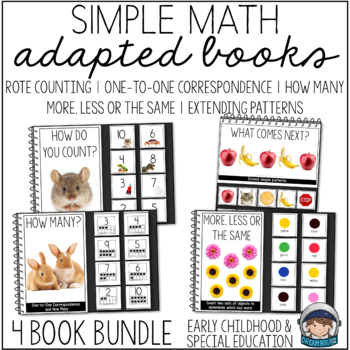Math Adapted Books with Real Image Photos Preschool Autism ADHD
- PDF
What educators are saying
Also included in
- If you’re looking for an engaging way to help your students reach IEP goals in ELA and MATH, or foundational skills these interactive books and resources are a good place to start. There are 24 adapted resources that target alphabet letter recognition, letter sounds, letter writing, learning colors,Price $26.25Original Price $37.50Save $11.25
Description
Need help meeting your preschool or special needs students IEP math goals? These interactive books are a good place to start. There are 4 adapted books that target counting to 10 (rote counting), one to one correspondence, determine how many, classify objects and determine if there are more, less or the same amount in two groups, and extending patterns.
These books are ideal for 3 year olds, preschool, kindergarten, IEPs, ESL, assessments, or for students with special needs like autism or ADHD.
What you get:
Detailed directions to assemble the book.
The following 4 Books
Book#1 How do you count?
This book practices counting out loud (rote counting), by using movement and different voices. The bottom of each page has a prompt to help you facilitate reading.
Book#2 How many?
This book practices one-to-one correspondence 1-10, and the last number counted is “how many”. Encourage the student to point to the black dots while counting if they struggle with tracking.
Book #3 More, Less or the Same
This book practices counting to determine which of two sets has more objects and to classify which has more, less or the same.
Book #4 What Comes Next?
This book practices extending patterns: AB, ABB, AAB, AABB, ABC, and AABBCC. To accommodate one-line patterns the book is assembled portrait instead of landscape.
Materials needed:
If you choose to assemble the way I have done in the preview, you will need: a laminator, higher quality copy paper (optional but makes the images pop), binding materials (like a 1” book ring, or coil rings), Velcro, and cardstock (for the back of each book)
Looking for more?
What makes this resource special:
I use real high quality images that can appeal to students that struggle with abstract clipart
Skills developed in this resource:
Math
- Count to ten by ones
- Name written numerals 0-10, count a number of objects 0-10 and associate written numeral
- One to one correspondence 1-10, last number counted is “how many”
- Count to determine which of two sets has more objects up to 10
- Associate written quantities with written numerals
- Duplicate and extend patterns
- Classify more, less, same
I love followers!
Click here to follow me to get first access to store discounts, free products and product launches.
Thank you,
Teresa from Dream Big Little One






